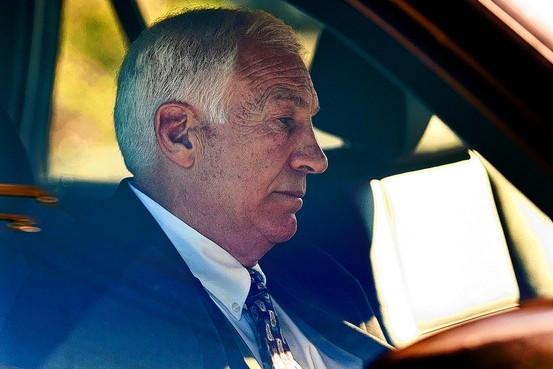By Ashby Jones
Wall Street Journal
November 17, 2011
http://online.wsj.com/article/SB10001424052970204517204577042491094936470.html
The scandal surrounding ex-football coach Jerry Sandusky and others at Pennsylvania State University is casting a spotlight on a distinctive part of the state's criminal-justice system.
In the federal system and most states that use the grand-jury system, grand juries typically unveil their criminal allegations against someone in an indictment or a criminal complaint. Such documents are usually tersely worded and can run as few as three or four pages, stating only the most essential factual allegations. They also often use initials or pseudonyms to protect people who aren't criminally charged.
But Pennsylvania is one of a handful of states in which grand juries occasionally issue a "presentment," or report, to convey their findings. Presentments, including the one this month in the Penn State case, read as narratives rather than a set of allegations that must be proved in court.
Mr. Sandusky was charged this month with 21 felony counts related to alleged sexual abuse of youths, just after the grand-jury presentment that suggested he had abused boys over 15 years. He has said he is innocent.
Legal experts say presentments have fallen out of favor in most states and the federal system because they are often viewed as prejudicial and inflammatory both to those charged with crimes, such as Mr. Sandusky, and those who aren't, such as Mike McQueary, a Penn State assistant coach who told the grand jury he witnessed an incident in a shower involving Mr. Sandusky and a young boy.
"They're one-sided and unfair, and in some instances can be inquisitorial," said Bennett Gershman, a law professor at Pace University and a former prosecutor.
 |
| Former Penn State coach Jerry Sandusky after his Nov. 5 arrest. |
But Mr. McQueary and others have stepped forward to defend Mr. McQueary's behavior, according to news outlets including the Morning Call of Allentown, Pa., and NBC News, with Mr. McQueary saying he made sure the alleged assault stopped.
Mr. McQueary didn't respond to repeated requests for comment.
Others have also claimed the presentment got facts wrong. According to the grand-jury report, Wendell Courtney, an attorney for Penn State, also worked as an attorney for the Second Mile, a charity that Mr. Sandusky founded, in 1998. But Mr. Courtney said he wasn't working for the organization in 1998.
Mr. Paterno, who was fired last week, has said he reported what Mr. McQueary told him to athletic director Tim Curley. According to the grand-jury report, Mr. McQueary notified Mr. Curley and Gary Schultz, the university's vice president for finance and business. Police were never informed, the report said.
Messrs. Schultz and Curley face charges of lying to the grand jury about what they knew of Mr. McQueary's allegations; both have said through their attorneys that they are innocent. Mr. Paterno said in a statement: "I wish I had done more." Penn State's president, Graham Spanier, also was removed. Messrs. Paterno and Spanier haven't been accused of criminal wrongdoing.
Michael Engle, a criminal-defense lawyer in Philadelphia who isn't representing anyone in the Penn State case, said Mr. McQueary, who was placed on indefinite leave from coaching, has been treated unfairly. "He hasn't been accused of anything, but now he carries a stigma; he's been branded as the individual who didn't do enough to stop the rape of a child. He's at the center of a storm," he said.
A spokesman for Linda Kelly, the prosecutor in the case and Pennsylvania's attorney general, said presentments are typical in cases brought by the attorney general's office. In these cases, "investigative" grand juries make findings and offer recommendations to prosecutors, who actually bring the charges. County prosecutors throughout the state more typically use grand juries that bring indictments on their own.
The use of presentments was common in the early part of the century but is now infrequent in many states and extremely rare in the federal system. When they are used, they often try to point out widespread or systemic failings within an institution—not to single out individual wrongdoing.
For instance, in 1986, former Manhattan District Attorney Robert Morgenthau convened a grand jury to investigate the events surrounding the death of 18-year-old Libby Zion two years earlier. Ms. Zion had died shortly after being admitted to New York Hospital with a host of strange symptoms. The grand jury declined to indict several doctors for murder, but issued a report critical of the way interns and junior residents at the hospital were supervised. (The report led to 1989 changes cutting back the number of consecutive hours medical interns were allowed to work in New York state.)
In Pennsylvania, grand juries issued a handful of presentments in recent years, including in the criminal case against Philadelphia doctor Kermit Gosnell, who was accused earlier this year of killing several babies who were born alive at his abortion clinic. Mr. Gosnell has pleaded not guilty and is awaiting trial.
And earlier this year, a Philadelphia grand jury issued reports highly critical of the Archdiocese of Philadelphia in the wake of numerous reports of child sex abuse within the Catholic church. Three Philadelphia priests were charged with raping and assaulting boys in their care. They have pleaded not guilty and are awaiting trial.
"Grand jury reports can be effective if they're used properly," says Gerald Lefcourt, a criminal-defense lawyer in New York. But Mr. Lefcourt said they can be mishandled. "The notion that the AG's office would write a report that's primarily critical of individuals is pretty outrageous given our present-day notion of due process and fairness," he said.
Write to Ashby Jones at ashby.jones@wsj.com
Any original material on these pages is copyright © BishopAccountability.org 2004. Reproduce freely with attribution.